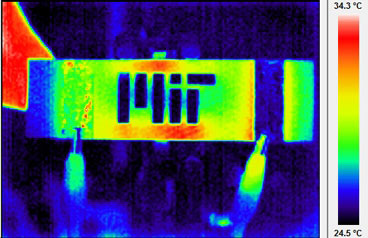| Mar 24, 2011 |
Seeing below the surface
|
|
(Nanowerk News) In recent years, many airplane manufacturers have started building their planes from advanced composite materials, which consist of high-strength fibers, such as carbon or glass, embedded in a plastic or metal matrix. Such materials are stronger and more lightweight than aluminum, but they are also more difficult to inspect for damage, because their surfaces usually don't reveal underlying problems.
|
|
"With aluminum, if you hit it, there's a dent there. With a composite, oftentimes if you hit it, there's no surface damage, even though there may be internal damage," says Brian L. Wardle, associate professor of aeronautics and astronautics.
|
 |
| Infrared themographic image of a nanoengineered composite heated via electrical probes (clips can be seen at bottom of image). The scalebar of colors is degrees Celsius. The MIT logo has been machined into the composite, and the hot and cool spots around the logo are caused by the thermal-electrical interactions of the resistive heating and the logo "damage" to the composite. The enhanced thermographic sensing described in the paper works in the same way. (Image: Roberto Guzmán de Villoria, MIT)
|
|
Wardle and his colleagues have devised a new way to detect that internal damage, using a simple handheld device and heat-sensitive camera. Their approach also requires engineering the composite materials to include carbon nanotubes, which generate the heat necessary for the test.
|
|
Their approach, described in the March 22 online edition of the journal Nanotechnology, could allow airlines to inspect their planes much more quickly, Wardle says. This project is part of a multiyear, aerospace-industry-funded effort to improve the mechanical properties of existing advanced aerospace-grade composites. The U.S. Air Force and Navy are also interested in the technology, and Wardle is working with them to develop it for use in their aircraft and vessels.
|
|
Uncovering damage
|
|
Advanced composite materials are commonly found not only in aircraft, but also cars, bridges and wind-turbine blades, Wardle says.
|
|
One method that inspectors now use to reveal damage in advanced composite materials is infrared thermography, which detects infrared radiation emitted when the surface is heated. In an advanced composite material, any cracks or delamination (separation of the layers that form the composite material) will redirect the flow of heat. That abnormal flow pattern can be seen with a heat-sensitive (thermographic) camera.
|
|
This is effective but cumbersome because it requires large heaters to be placed next to the surface, Wardle says. With his new approach, carbon nanotubes are incorporated into the composite material. When a small electric current is applied to the surface, the nanotubes heat up, which eliminates the need for any external heat source. The inspector can see the damage with a thermographic camera or goggles.
|
|
"It's a very clever way to utilize the properties of carbon nanotubes to deliver that thermal energy, from the inside out," says Douglas Adams, associate professor of mechanical engineering at Purdue University. Adams, who was not involved in the research, notes that two fundamental challenges remain: developing a practical way to manufacture large quantities of the new material, and ensuring that the addition of nanotubes does not detract from the material's primary function of withstanding heavy loads.
|
|
The new carbon nanotube hybrid materials that Wardle is developing have so far shown better mechanical properties, such as strength and toughness, than existing advanced composites.
|

